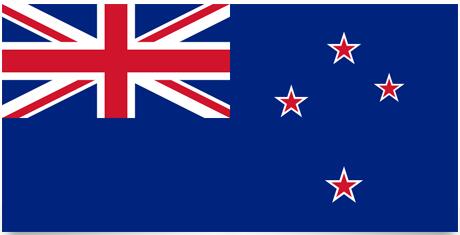New Zealand Flag and Meaning
Flag of New Zealand

New Zealand Flag Meaning
In the inner edge of the flag, at the top of the corner, you will find the British flag in a miniature. This is due to the time when New Zealand was a British colony. The four red stars with white edges, is a stylized version of the constellation Southern Cross. The actual constellation has five stars but they have chosen to show only four stars in the flag; Acrux, Becrux, Gamma Crucius and Delta Crucius. The one who is missing is called Epsilon Crucius.
The constellation is found in the southern starry sky and in the flag it is a symbol of the country’s location in the Southern Hemisphere. The flag was adopted on June 12, 1902.
New Zealand Overview
| Population | 3.8 million |
| Currency | New Zealand Dollar |
| Area | 270.534 km² |
| Capital city | Wellington |
| Population density | 14.0 residents/km² |
| HDI location | 3 |
Aotearoa, New Zealand, is located in the Pacific Ocean. The two main islands are relatively mountainous: North Island is volcanic, with highlighters and geysers. South Island is intersected by a mountain range, with peaks exceeding 3,000 feet. The climate is temperate and rainy, quite cold in the south. The original vegetation disappeared almost completely during colonization to allow for cultivated areas and pastures. The country’s economy is based on agriculture, with highly developed processing technology. New Zealand is the world’s fourth largest sheep breeding country. The main export goods are meat, dairy products, wood, seafood and wool.
The people: The majority are descended from the European colonizers, 71.8%, Maoris make up 12.6% and Polynesians from the Pacific islands make up another 5%.
Religion: Anglicans dominate alongside other Protestant groups; there is a Catholic minority, 14.8% and several different Maori faiths.
Languages: English and Maori are the official languages, of these two English is the most widely used
Political parties: The multi-party system has been in a transitional phase since the country introduced a proportional electoral system (as in Denmark) in 1996, in contrast to the former British-inspired system based on single-person constituencies. New Zealand’s Worker Pair; The National Party; New Zealand First Party; United Future New Zealand; The Greens; ACT; The Progressive Coalition and several minority parties.
Social organizations: The Association of Trade Unions (CTU) and the Trade Union Council.
Official name: Aotearoa (Maori), New Zealand (English).
Administrative Division: Divided into 58 districts and 15 villages.
Capital: Wellington, 386,000 residents (2009).
Other important cities: Auckland, 1,120,000 residents; Christchurch, 344,000 residents; Hamilton, 172,400 residents; Dunedin, 111,400 residents; Palmertson N, 75,700 residents (2002).
Government: Restricted Monarchy; a member of the Commonwealth. Patsy Reddy, Governor General since September 2016. Jacinda Ardern, Prime Minister and Head of Government since October 2017.
Aotearoa is parliamentary-led, with a one-chamber system, made up of 120 members. The members elected to government form a cabinet headed by the Prime Minister. On special occasions, this Cabinet acts as advisers to the Governor-General. He appoints the Cabinet on the basis of the Prime Minister’s recommendations and he has the opportunity to dissolve Parliament.
National Day: February 6, Waitangi Day (1840).
Armed Forces: 9,870 men. (2001).
Dependent areas: Cook, Niue, Tokelau.













































